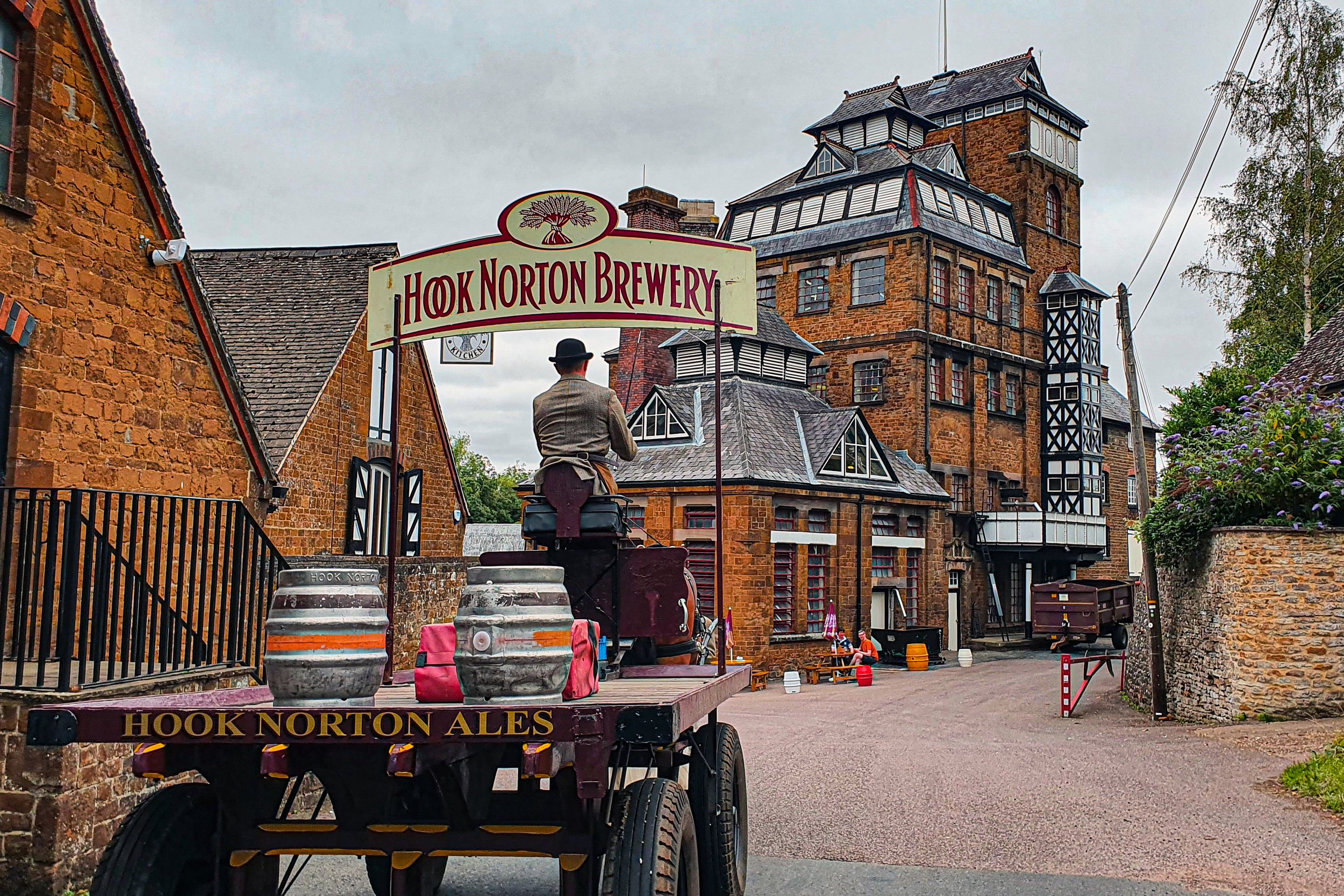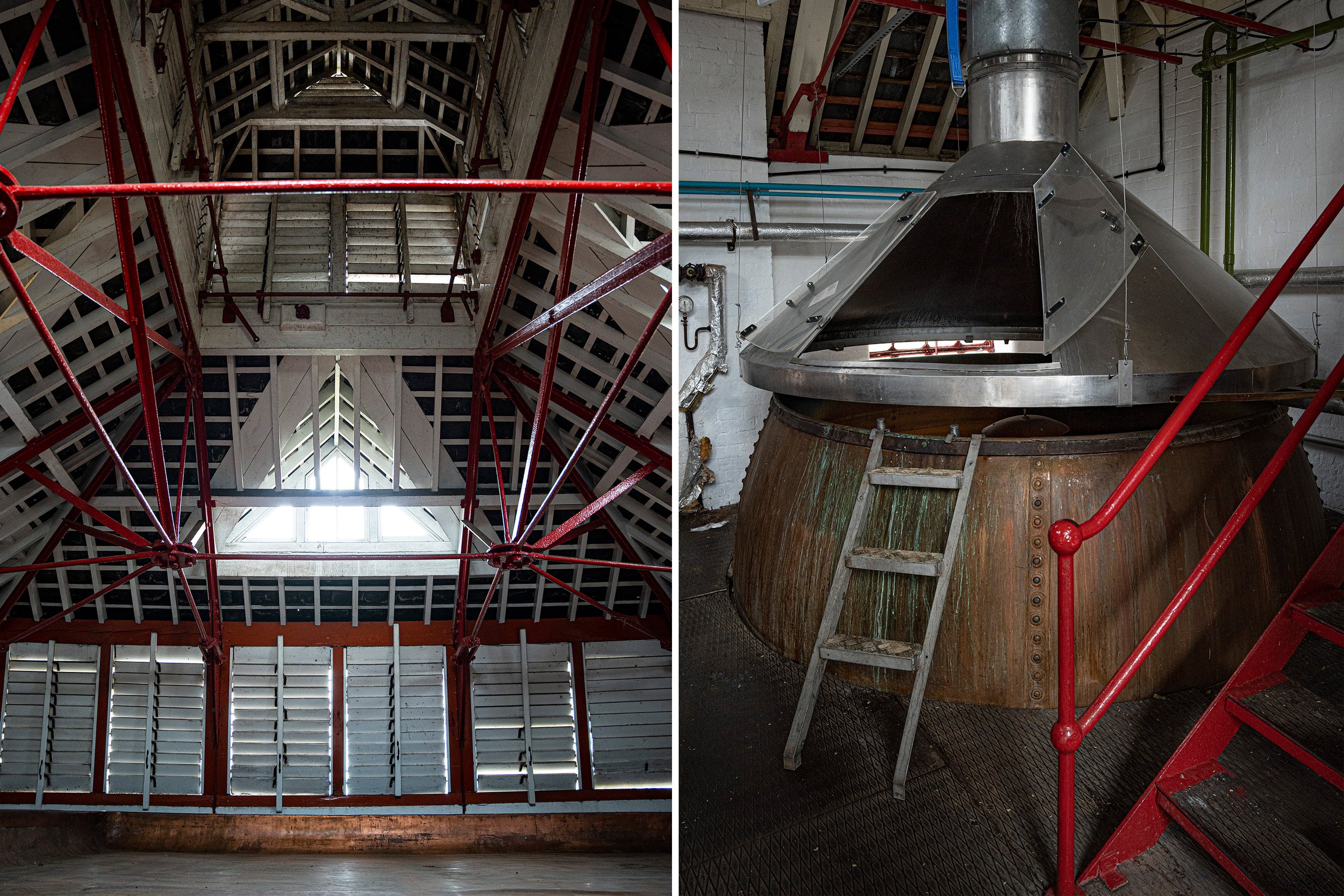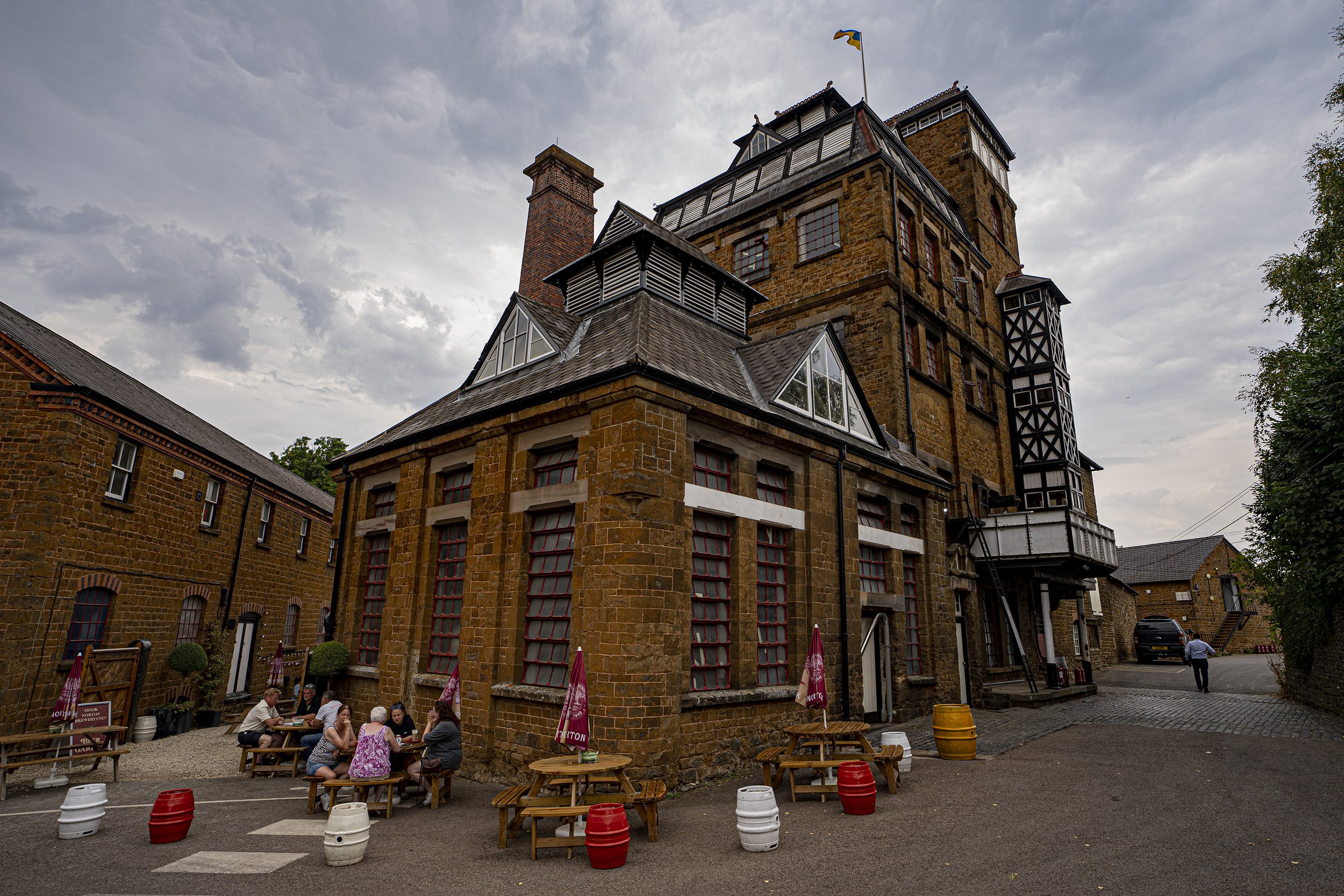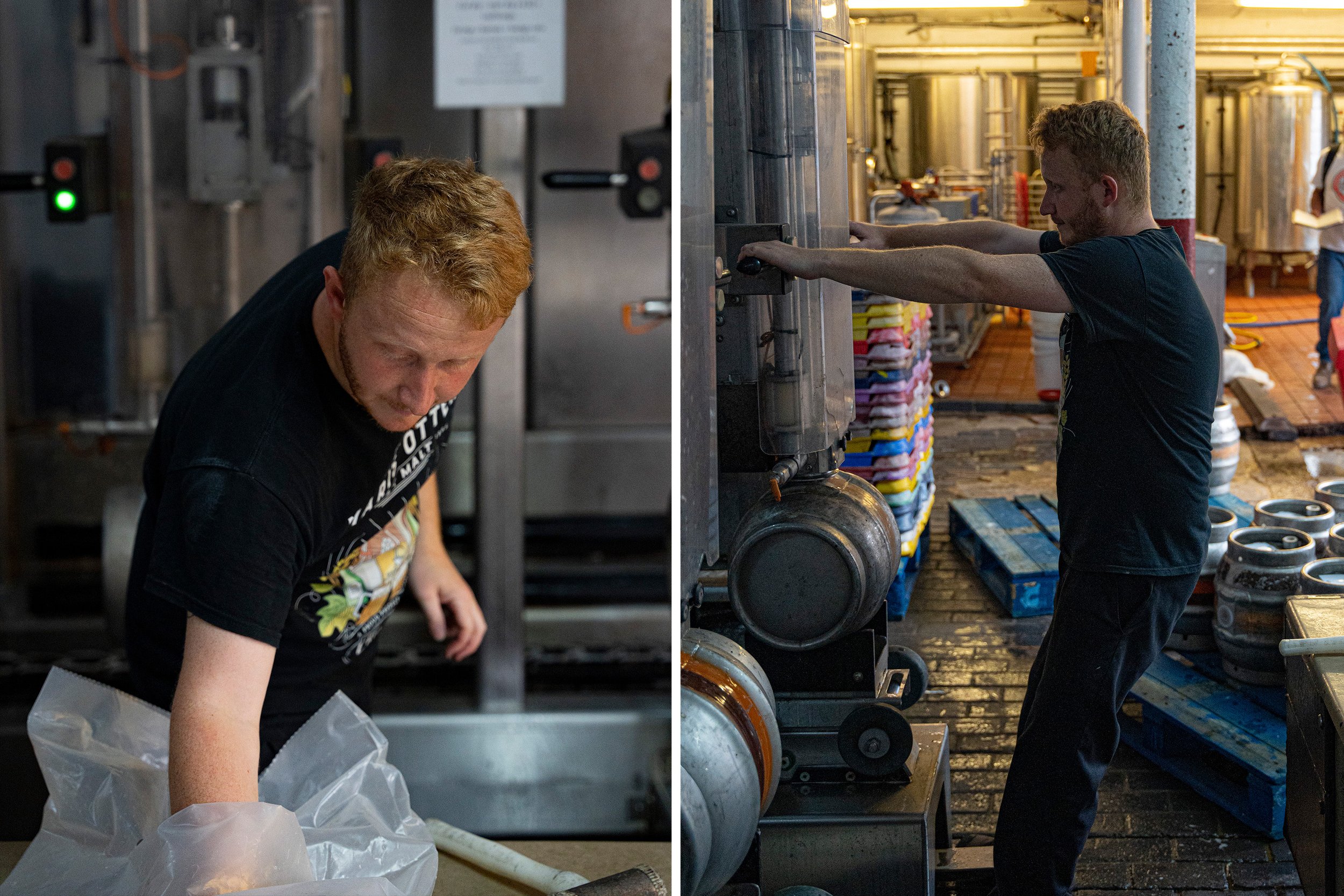The passage of time has the habit of fogging up the lenses through which we see the past. Did my three-year-old self really witness an elephant leading a parade when the circus came to town? Was the first day at school the adventure I always thought it was? I don’t know. But some memories yet have a clarity that shines like a luminous beacon. Yes, I remember being taken to my first football match when I was six. I remember my first encounter with a beguiling perfume—the sweet smell of spilled beer and cigarette smoke—when passing the open door of a pub in my hometown of Llandudno, Wales.
For Hook Norton Brewery’s managing director James Clarke, whose great-great grandfather John Harris was the brewery’s founder, there is certainty in the memories of his first trips to see the family business when he was five years old.
“I recall lots of noise,” he says as we sit opposite the brewery’s former maltings, now a shop and restaurant. “The steam engine ran everything then, starting and stopping regularly. If you came in the week, it would smell of hops, but at weekends it was quiet and you could smell the wood, plus a sort of biscuity maltiness and more of a yeasty smell.”
His grandfather Bill Clarke, who then held the post that Clarke now occupies, brought him along on those early visits. Now in his early 50s and a respected figure within British brewing, Clarke can still recall the impressions that a trip around the brewery made on his young self. “It was always a mystery to me, and I was still finding different rooms until my teens,” he says. “There was a lot of romance. You could see the building on a foggy night and it was quite eerie—or also at night with all the lights on.”
Since 1849, Hook Norton has resided in the village that shares its name, which is located in the rural north of Oxfordshire, where narrow lanes are overhung by lush green boughs from venerable trees. This is an ancient landscape, as I was reminded earlier in the morning when driving past the nearby Rollright Stones, a prehistoric circle of standing stones that has endured the changing seasons for at least 4,000 years. (As legend holds, they were once a king and his army, turned to stone by a witch.)
It is also a landscape that proffers a comfortable, secular vision of Englishness, one suggesting security, history, a sense of place. Many houses—some thatch-roofed—are built with the warm, honey-colored stone of the Cotswolds, whose ability to fade with grace is on a par with a leather biker jacket’s. The phrase “postcard-perfect” was made for Hook Norton, both village and brewery.
“We still use open fermenters, and when we had to replace two old wooden round ones, they were replaced with open stainless steel vessels. We like fermentation in a relatively shallow vessel, particularly our session Bitter Hooky, which can dry out a bit too much if the wort depth is much over five feet. It also enables us to keep an eye on the yeast, and have a chat with it each day.”
Even though brewery founder John Harris came to the village in 1849, when he bought a farm that included a maltings, it wasn’t until 1856 that the first brew took place, with brewery records noting the production of a Mild XXX. Several years later the first pub was bought, the start of an estate of pubs that now numbers 36. During the 1880s, the brewery’s star continued to rise with the construction of a railway line into the village, which helped with both transporting beer out to customers and bringing in raw materials (it was closed in the 1960s).
Meanwhile, Harris died in 1887, and his nephew Alban Clarke took over. He oversaw the building of the late-Victorian tower brewery, which was designed by the noted architect William Bradford (he specialized in breweries and maltings, and was also responsible for Harvey’s in Lewes, among many others). Throughout the 20th century, Hook Norton, like all surviving family breweries, weathered the storms of recession, war, and a changing landscape of beer.
Today, unlike a majority of U.K. breweries, Hook Norton is right in the middle of a living village, flanked by its neighboring pubs and the 1,000-year-old parish church. It stands steadfast and part of its community. This is the brewery’s great strength, according to brewing supervisor Andy Thomas, who joined seven years ago after working in the music industry.
“For us, we are close to our customers,” he says. “We are family-run, and want to keep it that way. A lot of the lads who work here are local and the brewery puts a lot into the community. On the brewing side, we are a tight-knit, compact team. When I started, we were 10, and now we are five. We are also really trying to hold onto using English hops; we work a lot with the hop merchants Charles Faram in the next county.”
When you arrive at the brewery site just down Brewery Lane, it’s worth taking time to consider the view. There is the old brewhouse, weathered by time and topped by what looks like a large dovecote. Bradford’s brewhouse is next to it, with an array of mullioned windows that look over the village and the surrounding countryside, and a pagoda-like roof that is nearly twice its height. Finally, overlooking the two is the tower, where everything begins by a process of gravity; the Ukrainian flag flutters above. The three buildings are joined together and reach down towards the ground like a trio of giant steps.
Inside, Hook Norton is a place of wooden steps and flooring, whitewashed walls, and a working steam engine that was installed in 1899, though it isn’t used for powering the brewery anymore. Those that visit on the daily tours might think they are in a museum. But this is a working brewery, as the clang of metal casks being filled with fresh beer makes clear.
“We still use open fermenters, and when we had to replace two old wooden round ones, they were replaced with open stainless steel vessels,” says Clarke. “We like fermentation in a relatively shallow vessel, particularly our session Bitter Hooky, which can dry out a bit too much if the wort depth is much over five feet. It also enables us to keep an eye on the yeast, and have a chat with it each day.”
I have many fond memories of drinking Hook Norton’s beers. One of the most memorable occasions was in a Worcester pub prior to attending a concert at the cathedral. I had an hour to kill and, having traveled by train, decided to have a couple of pints beforehand. The beer was Hook Norton’s Best Bitter Old Hooky, and as I sat in the pub, I engaged with its massive punch of earthy hopping, its silk dressing gown of malt, as if delivered on a tray with mocha coffee and a hint of milk chocolate on the side, plus a small bowl of fruit salad. The finish featured a lasting dryness and an explosion of bitterness. I ended up having several pints, which made for a particularly uncomfortable first half of the concert.
Old Hooky, like the brewery that makes it, is a survivor. First brewed in 1977 to celebrate the late Queen Elizabeth II’s Silver Jubilee, it was then, at 4.6% ABV, seen as a strong beer. The fact that it remains a central part of Hook Norton’s portfolio is testimony to the brewery’s ability to have one foot in tradition and heritage and the other in now and the future.
This balancing act has been upheld by several generations, and Clarke is the most recent steward. Quiet and unassuming, but passionate in his love for the brewery and the beers it makes, he’s a modest but determined person. “At his heart I think James is a modernizer, who realized that Hook Norton needed to change, adapt, and invest in the brewery, brands, and its pubs if it was to survive,” says beer writer Tim Hampson, who used to produce Hook Norton’s monthly newsletter. “One of the best bits of advice he was given was that he should take time each week to read about beer and brewing and talk to people not just within the company but outside it. The knowledge he gained enabled him to step away from the shadow of the past and cast his own shadow onto a new path.”
Clarke is an avowed lover of session Bitters, and says that he doesn’t go to the pub to drink but to meet people, though he will have some beers when he meets people. For him, the beers that Hook Norton produces must have a drinkability, whether it be Hooky Bitter; the winter Porter, Twelve Days; Double Stout; or even the relatively new Lager, Ironstone, which in Clarke’s words is “properly stored.” While the traditional beers are the bedrock of Hook Norton’s appeal, the young brewing team, including Clarke’s son, George (his other son, Ed, works at Gipsy Hill Brewing in London) also has a pilot kit where they can play around with new flavors.
“They get the opportunity to try a few new recipes, and this way they develop some new beers on the pilot brewery,” says Clarke. “I want more of that. But I think the most important thing is to say, OK, when I have that pint of Hooky, that 3.5% session beer, if you can get that right, that’s the hardest part to get that flavor in the beer and the consistency. If the pint of Hooky is good in the pub, then life is generally quite good.”
George Clarke, who joined the brewery five-and-a-half years ago, after briefly considering joining the armed forces, agrees with his father on the joy of a pint at the end of the working day. Coming to work for Hook Norton, he seems to suggest, had a certain feeling of inevitability.
“I was always kind of helping out when it was needed,” he says. “And once I fell into it, I realized how it is such a damn good job, despite things like early starts. It is brilliant to sit down at the end of day with a pint that you made a couple of weeks before, and we also have a great social atmosphere in the workforce, in my opinion the best team we have ever had.”
Beer may be a business, but there is something metaphysical about the liquid in the glass. It is an intoxicant in more ways than one. People feel a loyalty to a favorite beer or brewery, especially in a tight-knit community like Hook Norton, and they want to visit the brewery; ask questions; and drink Hooky Bitter, Double Stout, or Flagship IPA.
I have always thought that Hook Norton is an ideal manifestation of Englishness. Theirs is an Englishness of George Orwell and Nick Drake, of Shakespeare and the Rollright Stones; a gentler and more benign version than the corrosive one of Brexit and narrow-minded nationalism. It’s the kind that was chronicled by poet and writer Edward Thomas, who traveled over hill and dale and wrote books about his experiences prior to World War I. Before he was killed in 1917, he had drafted soul-stirring poems like “Adelstop”—named, coincidentally, for a village close to Hook Norton.
It is a provincial kind of Englishness, in other words—slow-moving and meditative, but forged around the warmth of gathering and real feeling. These musings might be misty-eyed and hark back to a glowing past that never was, but they are also an anchor, a steady rock in our current times of war, pestilence, and general atrophy.
“I always see the brewery, in my mind’s eye, as sitting on the top of a hill—reminiscent of a motte and bailey castle above a village. The firm’s fire brigade and horse-drawn drays enhance this image but, most importantly, the company’s benevolence to the community is tangible. Combined with their beer quality, it has created a fierce local loyalty that is well- deserved.”
Clarke, too, feels these sentiments in connection with the brewery. “I guess a lot of it is location, particularly in the spring and early summer looking at the patchwork of green fields,” he says. “It is also a bit about community, about being individual. Sometimes you’ve had a couple of weeks away abroad and that’s the thing you really miss, and I’m not sure what it is. But you miss that so much. I want to see that pint of Bitter in a dimpled tankard and maybe hear the sound of the leather on the willow [author’s note: a reference to the game of cricket]. It’s just something but I don’t know what it is, it’s very hard to articulate.”
Clarke’s peers—including Miles Jenner, head brewer and managing director of Harvey’s (another brewery that might be said to represent this Platonic Englishness)—share these associations.
“My experience of Hook Norton spans two generations, as James’ father was 10 years older than me and James is 20 years younger,” Jenner says. “In the contemporary brewing scene they fit into the category of ‘survivors’—working from a heritage site and perpetuating a traditional system of brewing, but innovating and remaining relevant. ‘Englishness’ is an interesting term. I always see the brewery, in my mind’s eye, as sitting on the top of a hill—reminiscent of a motte and bailey castle above a village. The firm’s fire brigade and horse-drawn drays enhance this image but, most importantly, the company’s benevolence to the community is tangible. Combined with their beer quality, it has created a fierce local loyalty that is well-deserved.”
Another brewer to whom I reached out for comment was Adnams Brewery’s production director, Fergus Fitzgerald. Like Hook Norton, Adnams has its roots in the 19th century and also straddles traditional and modern beer styles.
“I think they are completely outside of the contemporary brewing scene in some ways,” he told me. “It is like asking what a grandfather clock thinks about that nice new digital watch. I’ve been struggling with the idea of ‘Englishness,’ I simply don’t know what it is, but Hook Norton is undeniably very English. It’s got a stubborn history drifting through the brewery building, but then so do a lot of German breweries—the architecture is a bit different but they are no less historic.”
Hook Norton could so easily be a fusty, ultra-traditional brewery, the kind that preserves itself in aspic and looks askance at a beer world of wild flavors and adjunct-heavy gimmicks. Instead, it has handled the change in the British beer world during the past 15 years with a real adroitness. Alongside breweries like Fuller’s and Shepherd Neame, it has reached back into its copious archives to brew beers that are true to its legacy but which speak to the present day. One example is Merula Stout, a smooth yet roasty dark beer that is based on a recipe from 1899, when such styles were a prime part of an English country brewery’s portfolio.
Double Stout, first brewed in its modern incarnation in 1996, is another example (it is George Clarke’s favorite beer). It had been discontinued during World War I, when the brewery’s maltings closed due to a shortage of coke for the kilns. According to Clarke, it was last brewed in 1917, when he assumes that there was a shortage of black malt.
These historic archives, which show that the brewery used American hops before 1914, are a treasure trove of inspiration. Then there is the aforementioned pilot plant, which was brought in several years ago. This gives the brewing team the ability and agility to produce short runs of beer styles that would not otherwise fit within Hook Norton’s portfolio, including the Session Black IPA Crafty Fox and Resist Beetroot Stout, a beer produced in conjunction with Drinkers for Ukraine.
“I visited for a tour as I am interested in all breweries, not least one with so much history. Then we just chatted and decided to make a beer together. I love the brewery, the beers, and the history, so it was a privilege to brew with Hooky. It is sort of magical—like walking into a museum.”
This latter beer is something Clarke feels very strongly about: He has driven twice to Ukraine in a four-wheel-drive vehicle carrying vital supplies and, when we meet, is planning to do a third trip. According to George Clarke, his father has always been strong on charity work, and the business has routinely helped out the local community. “So when he saw the destruction of communities out there, it made sense for him to chip in a bit, take over medical supplies and other essential items. He felt strongly about it.”
Another way in which the brewery has recognized the vitality of the modern British brewing scene is through its collaborations. One recent collab was with the Cheltenham-based DEYA Brewing Company, known for its hazy, juicy Pales and IPAs. The result was an IPA, Since Records Began, using Hook Norton’s yeast strain and fruity U.S. hops. “We were really happy with the end result,” says Thomas, who went to DEYA for the brew day. “DEYA rejigged their own brew system so it could be like ours on the day, with the lauter tun acting as a hop back. They also mainly use pellets, but used hop leaves in the boil, like we do. I’m looking for the return collaboration at ours.”
The collaboration arose organically. “I visited for a tour as I am interested in all breweries, not least one with so much history,” says DEYA’s founder and head brewer Theo Freyne. “Then we just chatted and decided to make a beer together. I love the brewery, the beers, and the history, so it was a privilege to brew with Hooky. It is sort of magical—like walking into a museum. The countryside around is beautiful too. It is a great heritage brand which is honest and hard-working and certainly has a large standing in the area.”
After leaving the brewery, I return once more to the Rollright Stones. They stand in a circle, beyond which are views of farmland, wooded copses, and gentle hills. Another legend has it that they cannot be counted, but I don’t bother trying. Instead, I take the opportunity to slow down and look out over this canvas of various shades of green. I reflect on this place of folklore and Englishness—this place of country pubs, of roaring fires, and dimpled tankards of Bitter.











































